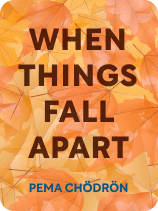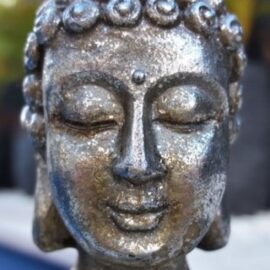

This article is an excerpt from the Shortform book guide to "When Things Fall Apart" by Pema Chödrön. Shortform has the world's best summaries and analyses of books you should be reading.
Like this article? Sign up for a free trial here.
What’s Pema Chödrön’s meditation style? What are the benefits of mindful meditation?
In When Things Fall Apart, Pema Chödrön asserts that cultivating mindfulness through meditation is the first step in learning how to cope with difficult times. It also allows you to use painful experiences as catalysts for experiencing peace in your life.
Continue reading to learn Pema Chödrön’s advice for practicing meditation to experience peace.
Practicing Meditation and Mindfulness
Pema Chödrön’s meditation advice includes practicing being with your experience in the present moment—whether it’s painful, enjoyable, or a mix of both—and accepting it. Notice without judgment whatever thoughts and feelings come up, then let them go and return to the present moment. The purpose of meditation is not to rid yourself of unpleasant thoughts or feelings, which is impossible. Because mindfulness leads to clarity and spaciousness around your thoughts and feelings, it helps you to not get swept away by your hopes and fears in hard times.
Additionally, you can see your habit of escaping certain emotions because you’re paying attention to your experience. You can then develop the ability to let your emotions be present without indulging them or repressing them. Chödrön explains that this mindful awareness can translate into your daily life if you practice meditation regularly. You’ll develop inner acceptance and peace, despite how your outer life may look.
| What Meditation Is and Isn’t In Mindfulness in Plain English, Bhante Gunaratana addresses some misconceptions about mindfulness and meditation in Buddhist traditions. He clarifies what meditation is and what it isn’t, which expands upon Chödrön’s description above. Meditation isn’t about achieving deep relaxation. As Chödrön explains, it’s about cultivating nonjudgmental awareness of your thoughts and sensations. Meditation isn’t about going into altered states of consciousness. As Chödrön describes, its purpose is to help you be more present in the moment, not escape the present. Meditation doesn’t give you supernatural abilities, like knowing the future. It is, however, a tool for getting to know yourself better, as Chödrön asserts. Meditation isn’t a self-centered practice. Cultivating an inner sense of stability, peace, and self-awareness supports you in having more kindness, patience, and compassion for others, which Chödrön also teaches. |
Chödrön teaches that only the present moment is real—the past and future are illusions. We all think about the past and future to escape the discomfort of everything we don’t know and can’t control. Therefore, as you learn to be more present, you may feel vulnerable because you have nowhere to escape to mentally. And Chödrön explains that when you have nowhere to hide from reality, your heart will open more fully to yourself, others, and the world.
(Shortform note: In The Power of Now, Eckhart Tolle agrees with Chödrön’s description of the illusory nature of the past and future and elaborates that when we try to escape the present, we only find more suffering. He explains that thinking about the past can cause us to feel remorse, anger, resentment, melancholy, and nostalgia. Thinking about the future causes anxiety, fear, powerlessness, and worry. He argues that learning to keep our minds in the present moment is the most powerful way to find peace.)
How to Meditate
Chödrön teaches a form of mediation called Shamatha-vipashyana and outlines the basic steps:
- Find a flat, level seat and sit with your torso upright, legs crossed comfortably in front of you or with your feet on the floor. With your eyes open, gaze softly at the floor ahead of you and relax your jaw.
- Lightly focus your attention on your exhaled breath without trying to change it.
- Relax and accept whatever arises in your mind and body, even unpleasant thoughts and feelings. As thoughts come up, gently label them as “thoughts” with an attitude of kindness and understanding toward yourself.
- When you feel distracted, come back to the sensation of your breath and scan your physical posture to reconnect with your body.
- Keep trying to notice your thoughts, label them “thoughts,” let them pass, and focus your attention on your breath.
(Shortform note: Shamatha-vipashyana is one type of mediation among many. Some types involve sitting still, as described above, but others, like the Zen Buddhist tradition of walking meditation or the Chinese martial art of Tai Chi, involve moving your body. These movement meditation practices have the same goal (developing mindfulness) as sitting meditation. Like Shamatha-vipashyana, these forms of meditation include focusing your attention on the present moment and on your breath and noticing your thoughts and sensations without judgment. Tai chi, however, adds choreographed movements while walking meditation allows you to walk freely outside.)

———End of Preview———
Like what you just read? Read the rest of the world's best book summary and analysis of Pema Chödrön's "When Things Fall Apart" at Shortform.
Here's what you'll find in our full When Things Fall Apart summary:
- How to find courage and compassion amid pain, loss, and uncertainty
- How to use pain and suffering to grow and transform your life
- Buddhist methods for easing suffering and finding inner peace






